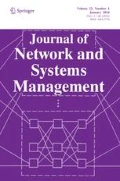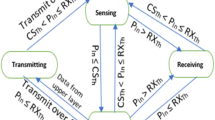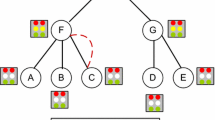Abstract
When an ATM node discovers that it cannot continue the setup of a virtual channel under the requested Quality of Service (QoS), it initiates a backtracking procedure called “crankback.” We propose a novel scheme, referred to as crankback prediction, that decreases the crankback overhead. Under the proposed scheme, nodes check during the connection admission control procedure whether the establishment of a virtual channel has a good chance to be admitted over the entire designated route. If this is not the case, crankback is initiated even before a particular QoS parameter is violated. The main idea behind the proposed scheme is to allocate a “quota” to the Peer Groups (PGs) along the message path, and then to suballocate this quota to the child PGs of these PGs. This process continues recursively until reaching the 1-level PG, which contains only physical nodes. The main advantage of the proposed scheme is that it lowers the setup delay and the processing and communication load imposed by signaling messages that establish unused portions of Virtual Channels (VCs)
Similar content being viewed by others
REFERENCES
C. Huitema, Routing in the Internet, Prentice Hall, New Jersey, 1995.
L. Kleinrock and F. Kamoun, Hierarchical routing for large networks. Computer Networks, Vol. 1, No. 3, pp. 155–174, 1977.
B.Awerbuch, A. Bar-Noy, N. Linial, and D. Peleg, Compact distributed data structures for adaptive routing (extended abstract). In Proceedings of the Twenty First Annual ACM Symposium on Theory of Computing, Seattle, WA, May 15-17, 1989, pp. 479-489.
B. Awerbuch, A. Bar-Noy, N. Linial, and D. Peleg, Improved routing strategies with succinct tables. Journal of Algorithms, Vol. 11, No. 3, pp. 307–341, 1990.
B. Awerbuch and D. Peleg, Routing with polynomial communication-space tradeoff. Technical Memo MIT/LCS/TM-411, Massachusetts Institute of Technology, Laboratory for Computer Science, July 1989.
B. Awerbuch and D. Peleg, Sparse partitions. In IEEE (ed.), Proceedings of the 31st Annual Symposium on Foundations of Computer Science, St. Louis, MS, Oct. 1990, IEEE Computer Society Press, Silver Spring, MD, pp. 503–513.
R. Cohen, E. Felstaine and R. Emek, A framework for multicast routing in hierarchical ATM networks. In IEEE INFOCOM, 2000.
D. Peleg and E. Upfal, A trade-off between space and efficiency for routing tables. JACM, Vol. 36, No. 3, pp. 510–530, 1989.
ATM Forum PNNI SWG 94-0471R13, ATM Forum PNNI Draft Specifications, Mar. 1996.
R. Cohen and A. Segall, Connection management and rerouting in ATM networks. In IEEE INFOCOM, 1994.
B. Awerbuch and Y. Shavitt, Topology aggregation for directed graph. Technical Report 98-14, DIMACS, Feb. 23, 1998.
W. C. Lee, Spanning tree method for link state aggregation in large communication networks. In IEEE INFOCOM, 1995.
W. C. Lee, Topology aggregation for hierarchical routing in ATM networks. In ACM SIGCOMM, April 1995.
W. C. Lee, Minimum equivalent subspanner algorithms for topology aggregation inATM networks. In 2nd International Conference on ATM (ICATM '99), Colmar, France, June 1999, pp. 351-359.
F. Hao and E. W. Zegura, On scalable QoS routing: Performance evaluation of topology aggregation. In IEEE INFOCOM, Tel Aviv, Israel, Mar. 2000.
I. Althofer, G. Das, D. Dobkin, D. Joseph, and J. Soares, On sparse spanners of weighted graphs, GEOMETRY: Discrete and Computational Geometry, Vol. 9, No. 1, pp. 81–100, 1993.
D. Peleg and A. A. Schaffer, Graph spanners. Journal of Graph Theory, Vol. 13, No. 1, pp. 99–116, 1989.
R. Guerin and A. Orda, Qos-based routing in networks with inaccurate information: Theory and algorithms. In IEEE INFOCOM, Kobe, Japan, Apr. 1997, pp 75-83.
D. Lorenz and A. Orda, QoS routing in networks with uncertain parameters. IEEE/ACM Transactions on Networking, Vol. 6, No. 6, pp. 768–778, 1998.
L. Guo and I. Matta, On state aggregation for scalable qos routing. In Proceedings of the 1998 IEEE ATM Workshop, IEEE, May 1998, pp. 306-314.
I. Ilias, Optimal PNNI complex node representations for restrictive costs and minimal path computation time. IEEE/ACM Transactions on Networking, Vol. 8, No. 4, pp. 493–506, 2000.
P. van Mieghem, Topology information condensation in hierarchical networks. Computer Networks, Vol. 31, No. 20, pp. 2115–2137, 1999.
B.Awerbuch,Y. Du, B. Khan, andY. Shavitt, Routing through networks with hierarchical topology aggregation. Journal of High Speed Networks, Vol. 7, No. 1, 1998.
B. Awerbuch, Y. Du, B. Khan, and Y. Shavitt, Routing through teranode networks with topology aggregation. In ISCCS'98, June 1998.
B. Awerbuch, Y. Du, and Y. Shavitt, Stars: A simulator for performance study of aggregation based hierarchical routing. In SCS/IEEE SPECTS'98, July 1998.
B. Awerbuch, Y. Du, and Y. Shavitt, The effect of network hierarchy structure on performance of ATMPNNI hierarchical routing. Computer Communications, Vol. 23, No. 10, pp. 980–986, 2000.
R. Krishnan, R. Ramanathan, and M. Steenstrup, Optimization algorithms for large self-structuring networks. In IEEE INFOCOM, New York, Mar. 1999.
D. G. Thaler and C. V. Ravishanka, Distributed top-down hierarchy construction. In IEEE INFOCOM, San Francisco, CA, Mar./Apr. 1998, p. 693.
G. Apostolopoulos, R. Guerin, S. Kamat, and S. K. Tripathi, Quality of service based routing: A performance perspective. In ACM SIGCOMM, Vancouver, Canada, pp. 17-28, August 1998.
S. Bahk and M. El Zarki, Dynamic multi-path routing and how it compares with other dynamic routing algorithms for high speed wide area networks. In ACM SIGCOMM, Baltimore, MD, Aug. 1992. Computer Communication Review, Vol. 22, No. 4, pp. 53–64, 1992.
I. Cidon, R. Rom, and Y. Shavitt, Multi-path routing combined with resource reservation. In IEEE INFOCOM, Kobe, Japan, Apr. 1997, pp. 92-100.
I. Cidon, R. Rom, and Y. Shavitt, Analysis of multi-path routing. IEEE/ACM Transactions on Networking, Vol. 7, No. 6, pp. 885–896, 1999.
T. Korkmaz and M. Krunz, Source-oriented topology aggregation with multiple qos parameters in hierarchical atm networks. ACM Transactions on Modeling and Computer Simulation, Vol. 10, No. 4, pp. 295–325, 2000.
J. Garcia-Luna-Aceves and J. Behrens, Distributed, scalable routing based on vectors of link states. IEEE Journal on Selected Areas of Communication, Vol. 13, No. 8, pp. 1383–1395, 1995.
M. Montgomery and G. de Veciana, Hierarchical source routing through clouds. In IEEE INFOCOM, San Francisco, CA, Mar./Apr. 1998, p. 685.
M. Montgomery and G. de Veciana, Hierarchical source routing using implied costs. Computer Networks, Vol. 34, No. 3, pp. 379–397, 2000.
C. Alaettinoglu and A. Shankar, The viewserver hierarchy for interdomain routing: Protocols and evaluation, IEEE Journal on Selected Areas of Communication, Vol. 13, No. 8, pp. 1396–1410, 1995.
S. Wright, D. Jarrett, D. Kataria, and Y. Viniotis, Accumulation algorithm for CDV. Technical Report 95-0556, ATM Forum, 1995.
B. Waxman, Routing of multipoint connections. IEEE Journal on Selected Areas of Communication, Vol. 1, pp. 1617–1622, 1988.
E. Felstaine and R. Cohen, On the distribution of routing computation in hierarchical ATM networks. IEEE/ACM Transactions on Networking, Vol. 7, No. 6, pp. 906–916, 1999.
E.W. Zegura, K. Calvert, and S. Bhattacharjee, How to model an internetwork. In Proceedings of IEEE INFOCOM '96, San Francisco, California, April 1996.
A. Iwata, N. Fujita, G. Ash, and A. Farrel, Crankback routing extensions for MPLS signaling. Internet Draft, Internet Engineering Task Force, Nov. 2001, work in progress.
A. Iwata, N. Fujita, G. Ash, and A. Farrel, Crankback routing extensions for MPLS signaling with RSVP-TE. Internet Draft, Internet Engineering Task Force, June 2002.
S. Venkatachalam, D. Papadimitriou, and S. Dharanikota, A framework for the LSP setup across IGP areas for MPLS traffic engineering. Internet Draft, Internet Engineering Task Force, Nov. 2001, work in progress.
D. Farinacci,Y. Rekhter,D.Meyer, P. Lothberg, H. Kilmer, and J. Hall, Multicast Source Discovery Protocol (MSDP). Internet Draft, draft-itef-msdpspec*.txt, Feb. 2000.
B. Hinden, M. O'Dell, and S. Deering, An IPv6 aggregatable global unicast address format. Internet Draft, Internet Engineering Task Force, July 1998, work in progress.
S. Kumart, P. Radoslavov, D. G. Thaler, C. V. Alaettinoglu, D. Estrin, and M. Handley, The MASC/BGMP architecture for inter-domain multicast routing. In ACM SIGCOMM, Sept. 1998.
Author information
Authors and Affiliations
Corresponding author
Rights and permissions
About this article
Cite this article
Felstaine, E., Cohen, R. & Hadar, O. Crankback Prediction in Hierarchical ATM Networks. Journal of Network and Systems Management 10, 327–355 (2002). https://doi.org/10.1023/A:1019862510606
Issue Date:
DOI: https://doi.org/10.1023/A:1019862510606




